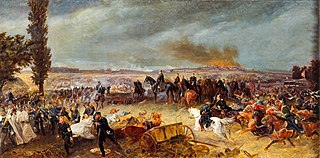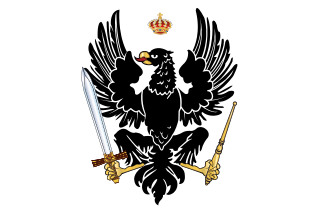
The Austro-Prussian War, also by many variant names such as Seven Weeks' War, German Civil War, Brothers War or Fraternal War, known in Germany as Deutscher Krieg, Deutscher Bruderkrieg and by a variety of other names, was fought in 1866 between the Austrian Empire and the Kingdom of Prussia, with each also being aided by various allies within the German Confederation. Prussia had also allied with the Kingdom of Italy, linking this conflict to the Third Independence War of Italian unification. The Austro-Prussian War was part of the wider rivalry between Austria and Prussia, and resulted in Prussian dominance over the German states.

The Kingdom of Prussia was a German kingdom that constituted the state of Prussia between 1701 and 1918. It was the driving force behind the unification of Germany in 1866 and was the leading state of the German Empire until its dissolution in 1918. Although it took its name from the region called Prussia, it was based in the Margraviate of Brandenburg. Its capital was Berlin.
The Grand Duchy of Tuscany and the United States formally recognized each other in 1794, but never formally established diplomatic relations. Despite this, both countries appointed representatives and established diplomatic offices until 1860 when the Grand Duchy was incorporated into the Kingdom of Italy.
Relations between the Kingdom of the Two Sicilies and the United States date back to 1796 when the U.S. was recognized by the Kingdom of Naples. Relations with the Kingdom continued when Naples reunified with the Kingdom of Sicily which founded the Kingdom of Two Sicilies in 1816. Formal relations were not established until 1832. Diplomatic relations ceased in 1861 when Two Sicilies was incorporated into the Kingdom of Italy.
Relations between the Kingdom of Sardinia and the United States began in 1802 with mutual recognition, but formal relations were not established until 1839. Diplomatic relations ceased in 1861 when Sardinia was incorporated into the Kingdom of Italy.
The Grand Duchy of Baden and the United States began relations in 1832 going through expansion in 1868 when the Duchy joined the German Empire in 1871. Relations would eventually end with World War I when the U.S. declared war on Germany.
The Kingdom of Bavaria and the United States began relations in 1833 going through expansion in 1868 when the Duchy joined the German Empire in 1871. Relations would eventually end with World War I when the U.S. declared war on Germany.
The Duchy of Brunswick-Lüneburg and the United States began relations in 1848 with mutual recognition but both countries never established formal relations. Relations continued in 1867 when the Duchy joined the North German Confederation. Relations would eventually end with World War I when the U.S. declared war on Germany.
The German Empire and the United States established relations in 1848. Relations would eventually be terminated a year later in 1849 when the Empire was dissolved and the German Confederation was re-established.
Relations between the Free Cities of Bremen, Lübeck, and Hamburg and the United States date back to 1790s when Hamburg became the first of the republics to recognized the U.S. on June 17, 1790. Bremen followed suit on March 28, 1794. Diplomatic relations were formally established in October 1853 when the U.S. received Rudolph Schleiden as Minister Resident of the Hanseatic Legation in Washington, D.C. Relations ended in 1868 as the republics would join North German Confederation.
The Grand Duchy of Hesse and the United States began relations in 1829 with mutual recognition going through expansion in 1868 when the Duchy joined the German Empire in 1871. Relations would eventually end with World War I when the U.S. declared war on Germany.
The Grand Duchy of Mecklenburg-Schwerin and the United States mutually recognized each other in 1816, but formal relations were never established. Relations continued when the Duchy joined the German Empire in 1871. Relations would eventually end with World War I when the U.S. declared war on Germany.
The Grand Duchy of Mecklenburg-Strelitz and the United States mutually recognized each other in 1853, but never formally established diplomatic relations. Relations continued when the Duchy joined the German Empire in 1871. Relations would eventually end with World War I when the U.S. declared war on Germany.
The Duchy of Nassau and the United States' mutual recognition occurred in 1846 when the two states signed a convention to abolish emigration taxes. During the Austro-Prussian War, the Duchy of Nassau fought on the side of Austria. On the losing side, the Duchy of Nassau was annexed to Prussia on October 3, 1866, ceased to be an independent sovereign state ending relations.
After the Austro-Prussian War the North German Confederation was established in 1866 with the United States recognizing the Confederation in 1867. Formal diplomatic relations were never established. Four years later the Confederation later merged with the German Empire where relations continued.
The Grand Duchy of Oldenburg and the United States began mutual recognition in 1829 but never established formal relations. Relations continued when the Duchy joined the German Empire in 1871. Relations would eventually end with World War I when the U.S. declared war on Germany.
The Principality of Schaumburg-Lippe and the United States mutually recognized each other in 1845, but never formally established diplomatic relations. Relations continued when the Principality joined the North German Confederation in 1867 then joined the German Empire in 1871. Relations would eventually end with World War I when the U.S. declared war on Germany.
The Kingdom of Württemberg and the United States began relations in 1825 when both countries mutually recognized each other. Relations continued when Württemberg joined the German Empire in 1871. Relations would eventually end with World War I when the U.S. declared war on Germany.
The Treaty of Amity and Commerce between the Kingdom of Prussia and the Tokugawa Shogunate (1861) opened diplomatic relations and trade between the two countries. This would come in a series of unequal treaties imposed on the Tokugawa Shogunate in its later stages.
The Kingdom of Prussia and the United States began diplomatic relations in 1785 following the signing of the Treaty of Amity and Commerce. But formal relations were not established until 1797. Relations would eventually end with World War I when the U.S. declared war on Germany.

